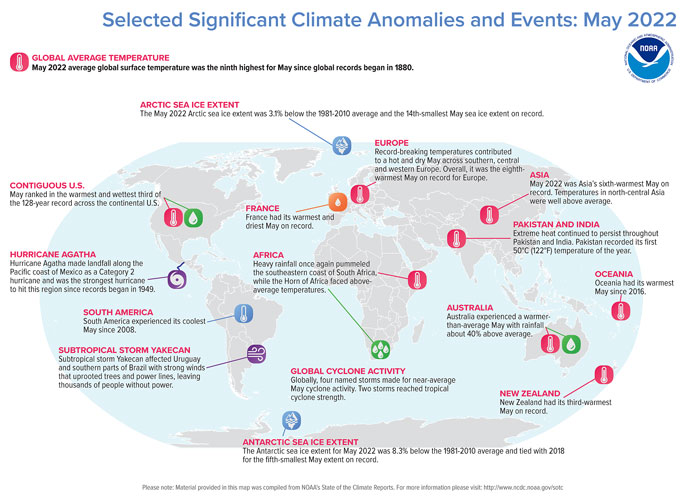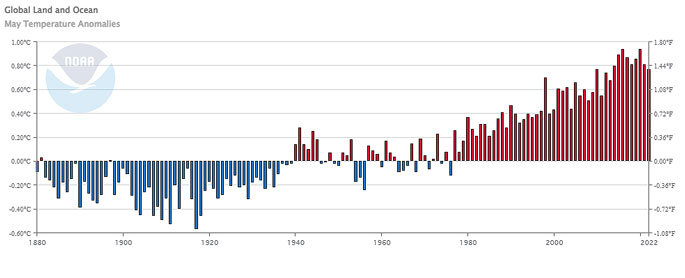 |
Weather Eye with John Maunder |

There were a number of significant temperature anomalies and events for May. Record-breaking temperatures contributed to a hot and dry May across southern, central and western Europe, with France having its warmest May on record.
Extreme heat continued to persist throughout Pakistan and India, and Pakistan recorded its first 50°C (122°F) temperature of the year. New Zealand had its third-warmest May on record.
Global temperature and other climate anomalies for May 2022 calculated by the US NOAA's National Centers for Environmental Information calculates the global temperature anomaly every month based on preliminary data generated from authoritative datasets of temperature observations from around the globe.
The major dataset, the US NOAAGlobalTemp version 5, updated in mid-2019, uses comprehensive data collections of increased global area coverage over both land and ocean surfaces. The US NOAAGlobalTempv5 is a reconstructed dataset, meaning that the entire period of record is recalculated each month with new data. Based on those new calculations, the new historical data can bring about updates to previously reported values.
These factors, together, mean that calculations from the past may be superseded by the most recent data and can affect the numbers reported in the monthly climate reports. The most current reconstruction analysis is always considered the most representative and precise of the climate system, and it is publicly available through Climate at a Glance.
The May global surface temperature was 1.39°F (0.77°C) above the 20th-century average of 58.6°F (14.8°C).
This ranks as the ninth-warmest May in the 143-year record, 0.30°F (0.17°C) cooler than the warmest May months (2016 and 2020). It was the coolest May since 2013, but it still marked the 46th consecutive May and the 449th consecutive month with temperatures, at least nominally, above the 20th-century average. The ten warmest May months have all occurred from 2010 to present.
There are several top-10 ranks to note for May 2022. In particular, it was the eighth-warmest May for the global ocean, the eighth-warmest for the Northern Hemisphere as a whole, the eighth-warmest for Europe (associated with a heatwave in southwestern Europe), and the sixth-warmest for Asia (associated with above-average temperatures in western Siberia).
Over the land surface, the largest warm anomaly in May was centered over north-central Asia, and the largest cold anomaly was centered over eastern Europe, with departures from average exceeding 4°C in both areas. Elsewhere, air temperatures were above average in southern and eastern North America, western Europe, central Africa, and most of Australia, while they were below average across parts of western North America, much of South America, parts of northern and southern Africa, and Southeast Asia.
Sea surface temperatures in May were above average across much of the northern and western Pacific, parts of the southeastern Pacific, and most of the Atlantic and Indian oceans. Consistent with La Niña, sea surface temperatures were below average over much of the tropical and southern subtropical eastern Pacific.
About seven per cent of the world's surface had a record-high temperature in May — the third highest May percentage since 1951.
Record-high temperatures were apparent over six per cent of the land surface (such as in western Europe, central Asia, and the Horn of Africa) and over about eight per cent of the ocean surface (particularly in the southern subtropical eastern Pacific).
None of the world's surface had a record-cold temperature in May.
There were a number of significant temperature anomalies and events for May. Record-breaking temperatures contributed to a hot and dry May across southern, central and western Europe, with France having its warmest May on record.
Extreme heat continued to persist throughout Pakistan and India, and Pakistan recorded its first 50°C (122°F) temperature of the year. New Zealand had its third-warmest May on record.
For further information on a range of weather and climate matters see my recent book "Fifteen shades of climate... the fall of the weather dice and the butterfly effect". Available from Amazon.


